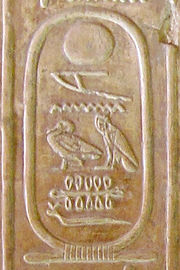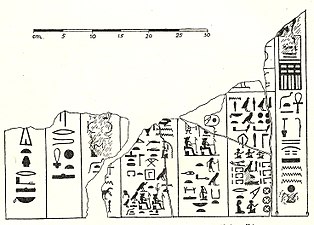Nemtiemsaef II.
| Name of Nemtiemsaef II. | ||||||||||||||||
|---|---|---|---|---|---|---|---|---|---|---|---|---|---|---|---|---|
 Name entry Nemtiemsaefs II. On the list of kings of Abydos
|
||||||||||||||||
| Horus name |
s… t3.wj The two countries… (assignment not secured) |
|||||||||||||||
| Throne name |
Ankh -ka-Re ˁnḫ-k3-Rˁ With a living Ka, a Re (assignment not assured) |
|||||||||||||||
| Proper name |
(Nemti em saef) Nmtj m s3 = f Nemti is his protection |
|||||||||||||||
| List of Kings of Abydos (Seti I) (No.39) |
Mr (j) -n-Rˁ-Ḏf3-m-s3 = f Loved by Re , Djefa is his protection (prescription) |
|||||||||||||||
|
Greek for Manetho |
Menthusuphis |
|||||||||||||||
Nemtiemsaef II. , In another reading Antiemsaef II. (Probably incorrectly also listed as Merenre II. ) Was the sixth king ( Pharaoh ) of the ancient Egyptian 6th dynasty in the Old Kingdom . He ruled briefly around 2180 BC. His rule falls during the transition from the dissolving Old Kingdom to the First Intermediate Period .
supporting documents
There are only two contemporary monuments from Nemtiemsaef's lifetime that can be assigned to him with some certainty. The first is a destroyed false door that was found in the vicinity of the Queen's Pyramid of Neith in Saqqara . This was already made when Nemtiemsaef was still Crown Prince.
The only document that can possibly be assigned to the time after his accession to the throne is a cult decree for the priesthood of the royal mothers Anchenespepi I and Neith, which was found in the mortuary temple of the Neith pyramid.
A third document could be assigned to him after Silke Roth . This is a relief fragment from the mortuary temple of Neith, which has probably been changed at a later date and which bears a heavily damaged throne name.
In the later king lists he is only listed in the king list of Abydos and in the royal papyrus Turin (both 19th dynasty , New Kingdom ). In the latter, however, his signature has not been preserved.
Name and numbering
The king had the proper name Nemtiemsaef or, in another reading, Antiemsaef ("(The god) Nemti (or anti) is his protection"). He already had this name as Crown Prince, which is evidenced by the designation Sa-nesu semsu Nemtiemsaef ("Elder King's Son Nemtiemsaef") on the false door fragment from the area around the Neith pyramid. In the scientific literature it is usually numbered Nemtiemsaef II./Antiemsaef II. To distinguish it from Merenre , who had the same proper name. It is unclear whether Nemtiemsaef II also carried the throne name Merenre (" Who is loved by Re "). There is no contemporary evidence of this. Only in the list of kings of Abydos created under Seti I is it listed as "Merenre-Djefaemsaef" (prescription of "Merenre-Nemtiemsaef"). According to the prevailing view of Egyptologists, this is probably a copyist's mistake. Nevertheless, he is in the literature, both under its own name and under the only hypothetical throne name "Merenre II." And its gräzisierter out form of the name "Menthesuphis II.".
After Silke Roth's reading of the relief fragment from the Neith mortuary temple, the throne name of King Anchkare could have been. He could thus be identical to a king known only from a letter from Elephantine (Papyrus Berlin 10523), whose throne name is read as Anchkare or Sechemkare . Since the throne name on the relief fragment shows neither a connection to a proper name nor a relationship to Queen Neith, its assignment to Nemtiemsaef must remain hypothetical for the time being.
On the cult decree from the mortuary temple of Neith, in addition to a completely illegible remnant of a throne name, the remainder of a Horus name , which can be read as Se- ... -taui ("The two countries ...").
Origin and family
Nemtiemsaef II was a son of King Pepi II and his wife Neith . A half-brother was the future king Neferkare Nebi . Other possible brothers or half-brothers were Nebkauhor-Idu and Ptahschepses . Nothing is known about women and children of Nemtiemsaef. Apart from Neferkare Nebi, the family relationship with the numerous kings of the 8th dynasty, who only ruled for a very short time, is completely unclear.
Domination

Nemtiemsaef II only ruled for a very short time. In the royal papyrus Turin only one year and one month are given for him. Also in the 3rd century BC Living Egyptian priests Manetho names only one year. This information is generally accepted in research. Nemtiemsaef must have been an elderly gentleman when he succeeded his father Pepi II on the throne after his very long reign. A renewed consolidation of the dissolving Old Kingdom was not possible for this pharaoh, the power of the princes was probably too great. Apart from the issue of a cult decree for the priesthood of the Anchenespepi I and the Neith, no details of his reign are known. There is no evidence that construction of a royal pyramid complex began. However, should a tomb still exist, its location would probably be near the Pepi II pyramid in Saqqara.
Legends about his death
According to a legendary tradition by the Greek historian Herodotus from the 5th century BC Nemtiemsaef II is said to have been murdered by the Egyptian people. His sister and successor in office Nitokris then avenged his death and then committed suicide. It is unclear whether parts of this story are based on fact. At least the existence of a Queen Nitokris can now be viewed as refuted, as her name entry in the Turin Royal Papyrus goes back to the reading of a male ruler's name.
Modern reception
The American writer Tennessee Williams made the act of revenge described in Herodotus the subject of his first published short story, The Vengeance of Nitocris , which appeared in Weird Tales magazine in 1928 . Nemtiemsaef only appears in this story as an unnamed pharaoh.
In 1943 the Egyptian writer Nagib Mahfuz published his second novel Radubis . In this story, partly inspired by the real past and partly by legends, Pharaoh Nemtiemsaef II (in the novel Merenre II) is married to a queen named Nitocris, but begins an affair with the courtesan Radubis, which leads to political problems and intrigues at the court. The figure of Radubis is based on the courtesan Rhodopis from the 6th century BC. BC, who according to Herodotus was assigned the building of the Mykerinos pyramid .
literature
- General
- Michel Baud : Famille royale et pouvoir sous l'Ancien Empire égyptien. Tome 2 (= Bibliothèque d'Étude. Volume 126/2). Institut Français d'Archéologie Orientale, Cairo 1999, ISBN 2-7247-0250-6 , p. 504 ( PDF; 16.7 MB ).
- Darrell D. Baker: The Encyclopedia of the Egyptian Pharaohs. Volume I: Predynastic to the Twentieth Dynasty (3300-1069 BC). Bannerstone Press, Oakville 2008, ISBN 978-0977409440 , pp. 211-212.
- Peter A. Clayton: The Pharaohs. Bechtermünz, Augsburg 1995, ISBN 3-8289-0661-3 , p. 67.
- Thomas Schneider : Lexicon of the Pharaohs. Albatros, Düsseldorf 2002, ISBN 3-491-96053-3 , p. 79.
- About the name
- Jürgen von Beckerath : Handbook of the Egyptian king names (= Munich Egyptological studies. Vol. 49). 2nd, improved and expanded edition of the first edition from 1984. von Zabern, Mainz 1999, ISBN 3-8053-2591-6 , pp. 64-65.
- Questions of detail
- Michel Baud: The Relative Chronology of Dynasties 6 and 8. In: Erik Hornung, Rolf Krauss, David A. Warburton (Eds.): Ancient Egyptian Chronology (= Handbook of Oriental studies. Section One. The Near and Middle East. Volume 83 ). Brill, Leiden / Boston 2006, ISBN 978-90-04-11385-5 , pp. 144-158 ( online ).
- Jürgen von Beckerath: Chronology of the pharaonic Egypt. von Zabern, Mainz 1994, ISBN 3-8053-2310-7 , pp. 27, 40, 148-152, 188.
- Aidan Dodson , Dyan Hilton: The Complete Royal Families of Ancient Egypt. The American University in Cairo Press, London 2004, ISBN 977-424-878-3 , pp. 70-78.
- Hans Goedicke : Royal documents from the Old Kingdom (= Egyptological treatises. Vol. 14). Harrassowitz, Wiesbaden 1967, pp. 158-162.
- Zahi Hawass : The Treasures of the Pyramids. Weltbild, Augsburg 2004, ISBN 3-8289-0809-8 , pp. 265, 275.
- Gustave Jéquier : Les pyramides des reines Neit et Apouit (= Fouilles à Saqqarah. ). Imprimerie de l'Institut français d'archéologie orientale, Cairo 1933, p. 55 ( online ).
- Miroslav Verner : The pyramids (= rororo non-fiction book. Volume 60890). Rowohlt, Reinbek bei Hamburg 1999, ISBN 3-499-60890-1 , p. 415.
Web links
Individual evidence
- ↑ a b Jürgen von Beckerath: Handbuch der Ägyptischen Könignames. Mainz 1999, p. 64, note 2.
- ↑ a b Silke Roth: The royal mothers of ancient Egypt from the early days to the end of the 12th dynasty. Harrassowitz, Wiesbaden 2001, ISBN 3-447-04368-7 , p. 157, fig. 80.
- ^ Rainer Hannig: Large Concise Dictionary Egyptian-German: (2800 - 950 BC) . von Zabern, Mainz 2006, ISBN 3-8053-1771-9 , p. 1259.
- ↑ a b c Jürgen von Beckerath: Handbook of the Egyptian king names. Mainz 1999, pp. 64-65.
- ↑ Year numbers according to Schneider: Lexicon of the Pharaohs . Düsseldorf 2002.
- ↑ Gustave Jéquier: Les pyramides des reines Neit et Apouit. Cairo 1933, p. 55, fig. 32.
- ↑ a b Kurt Sethe (ed.): Documents of the Egyptian antiquity. Volume 1. Documents of the old empire. Hinrichs, Leipzig 1933, p. 307 ( PDF; 10.6 MB ).
- ↑ Hans Goedicke: Royal documents from the Old Kingdom. Wiesbaden 1967, pp. 158–162, fig. 15.
- ↑ Silke Roth: The royal mothers of ancient Egypt from the early days to the end of the 12th dynasty. Wiesbaden 2001, pp. 154-158.
- ↑ a b T. Schneider: Lexicon of the Pharaohs. Düsseldorf 2002, p. 79.
- ↑ Darrell D. Baker: The Encyclopedia of the Egyptian Pharaohs. Volume I, Oakville 2008, pp. 211-212.
- ↑ Jürgen von Beckerath: Handbook of the Egyptian king names. Mainz 1999, pp. 70-71.
- ^ Aidan Dodson, Dyan Hilton: The Complete Royal Families of Ancient Egypt. London 2004, pp. 70-78.
- ↑ Jürgen von Beckerath: Chronology of the Pharaonic Egypt. Mainz 1994, p. 152.
- ↑ Miroslav Verner: The pyramids. Reinbek 1997, p. 415.
- ↑ Herodotus , Historien II 100; The History of Herodotus , parallel English / Greek, tr. GC Macaulay, [1890] - Herodotus Book 2: Euterpe [100]. At: sacred-texts.com , last accessed on September 27, 2014. (English).
- ↑ Kim Ryholt: The Late Old Kingdom in the Turin King-list and the Identity of Nitocris . In: Journal of Egyptian Language and Antiquity. No. 127, 2000, pp. 92-93.
- ↑ Francesca Hitchcock: Tennessee Williams's 'Vengeance of Nitocris': The Keynote to Future Works . In: Mississippi Quarterly 48: 4, 1995, pp. 595-608.
- ↑ Rhadopsis of Nubia by Naguib Mahfouz. In: Complete Review. Retrieved December 10, 2015.
| predecessor | Office | Successor |
|---|---|---|
| Pepi II. |
King of Egypt 6th Dynasty |
Nitokris |
| personal data | |
|---|---|
| SURNAME | Nemtiemsaef II. |
| ALTERNATIVE NAMES | Mer-en-Re II .; Nemti-em-saf II .; Menthusuphis; Antiemsaf II. |
| BRIEF DESCRIPTION | ancient Egyptian king of the 6th dynasty (around 2180 BC) |
| DATE OF BIRTH | 23rd century BC Chr. |
| DATE OF DEATH | 22nd century BC Chr. |



